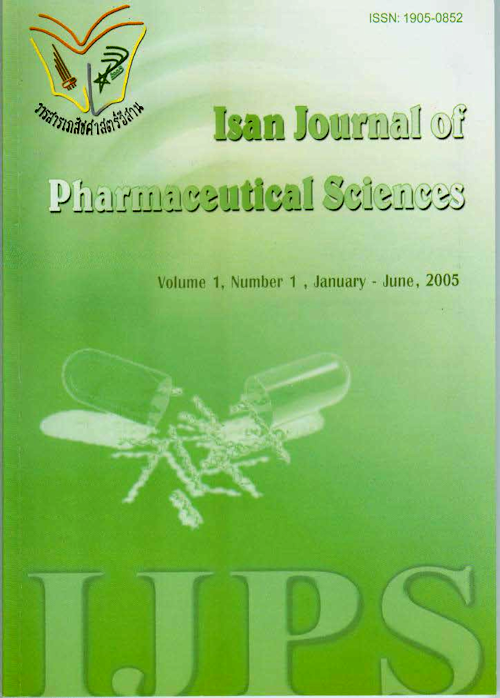Transportation and Metabolism of Prodrugs in Thai Human Skin
Main Article Content
Abstract
This study was to investigate the effect of physicochemical properties of nicotinic acid (NA) and its alkyl ester derivatives on both permeation and metabolism characteristics through Thai human skin. The horizontal (side by side) diffusion cell was used for all experiments in this study. Three alkyl ester derivatives of NA, methyl nicotinate (MN), ethyl nicotinate (EN) and butyl nicotinate (BN), were selected and used as the model prodrugs. Thai human skins were obtained from Srinagarind university hospital. The experiment of skin metabolism was conducted using skin homogenate at 37 °c. The concentrations of NA and its alkyl ester derivatives were determined by HPLC. Permeation profiles were plotted between cumulative permeated amount against time. The maximum steady state flux (J) was found as follows; MN (J =10.3493 mmol/cm2hr), EN (J = 2.2962 mmol/cm2/hr), BN (J = 0.3604 mmol/cm2hr) and NA (J =0.0552 mmol/cm2/hr), respectively. While the permeability coefficients (k) were as follows; EN (k =2.614lXlO-6 cm/sec), BN (k^ =9.6539Xl0-7 cm/sec), MN (kp =5.7496Xl0-7cm/sec) and NA (kp = 5.3093X10-8 cm/sec), respectively. The more lipophilic ester prodrug showed higher permeability through human skin. However, the k value of BN was lower than EN. Compared with EN, BN remained in the skin due to its higher partition coefficient. In this study, it was shown that the enzyme reaction of skin homogenates followed Michaelis-Menten S rule and BN showed high affinity to skin enzyme.
Article Details
In the case that some parts are used by others The author must Confirm that obtaining permission to use some of the original authors. And must attach evidence That the permission has been included
References
Chcing, Y.W.; Po, A.L.W. (1985). Cutaneous biotransformation as a parameter in the modulation of the activity of corticosteroids. Int. J. Pharm. 26: 175-189.
Das, M.; Mukhtar H.; Del Tito, B.J.; Marcelo C.L.; Bickers D.R. (1986).ClotrimazoIc, an inhibitor of benzo (a) pyrene metabolism and its subsequent glucuronidation, sulfation, and macromolecular binding in BALB/c mouse culture keratinocytes. J. Invest. Dermatol. 87: 4-10.
Ghosh, M. K.; Mitra, A. K. (1990). Carboxylic ester hydrolase activity in hairless and athymic nude mouse skin, Pharm. Res. 7 : 251-255 .
Lamb, K. A., Denyer, S. P., Sanderson, F. 0., Shaw, P. N. (1994). The metabolism of a series of ester pro-drugs by NCTC 2544 cells, skin homogenate and LDE test skin. J. Pharm. Pharmacol. 46 : 965-973.
Lilienblum, W.; Lrmscher, G.; Fusenig, N.E.; Bock, K.W. (1986). Induction of UDPglucuronyl-transferase and arylhydrocarbon hydroxylase activity on mouse skin and in normal and transformed skin cells in culture. Biochem. Pharmacol. 35 : 1517-1520.
Michel, SR.; Kenneth, AW. (1998). Dermal absorption and toxicity assessment. Marcel Dkkker, New York, ppl-12. 55-77 : 165-168.
Morimoto, Y.; Hatanaka, T.; Sugibayashi, K.; Omiya, H. (1991). Prediction of skin permeability of drug: comparison of human and hairless rat skin. J. Pharm. Pharmacol. 44 : 634-639.
Rittirod, T.; Hatanaka, T.; Kagami, N.; Katayama, K; Koizumi, T. (1999). Simutancous Transport and Metabolism of Nicotinic Acid Derivatives in Hairless Mouse Skin. Biol. Pharm. Bull. 22:305-9.
Rittirod, T, Hatanaka T, Uraki, A, Katayama. K.; Koizumi T. (1999). Species Difference in Simultaneous Transport and Metabolism of Ethyl Nicotinate in Skin. Int. J. Pharm. 178 : 161-9.
Rohatagi, S., Barrett, J.S., Mcdonald, L.J., Morris, E.M., Darnow, J., DiSanto, A.R. (1997). Seligeninc percutaneous absorption in various species and metabolism by human skin. Pharm. Res. 14 : 50-55.
Wanders, R.J., Van Roermund, C.W. (1993). Studies on phytanic acid alpha-oxidation in rat liver and cultured human skin fibroblasts, Biochim. Biophys. Acta. 11 67 : 345-350.


